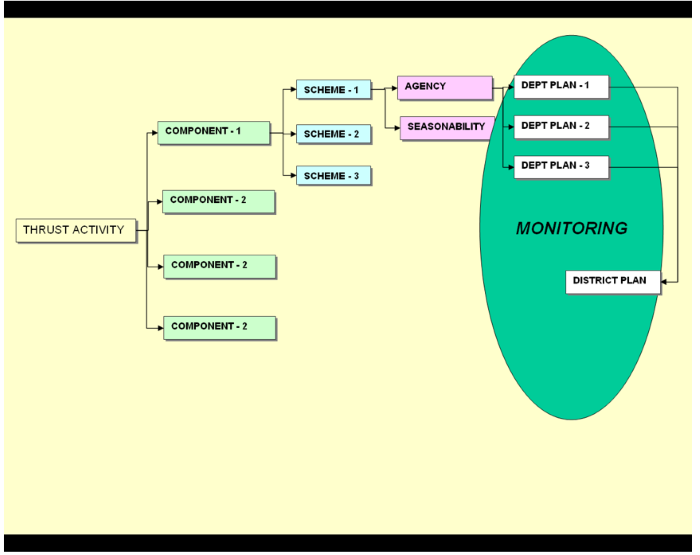
India has a ‘one district one product’ scheme for the country’s 600 districts to ensure social security and generation of sustainable income. It has taken inspiration from the Sustainable Development Goals set by the United Nations that talk about ‘no one should be left behind’ and the Chinese model of trans-village industry. The government has identified agriculture including fisheries, poultry, horticulture, and medicinal crops as the thrust area. If approached scientifically on the thrust area approach, it has the potential to deliver excellent results. The Union government is presenting the one district one product (ODOP) concept as the panacea for growth and employment challenges.
The total developmental funds available to each district every year is between Rs 800 crore and Rs 1200 crore. This includes allocation to all Union and state government schemes run by different departments and agencies involved in developmental activity. This does not include revenue expenditure including salaries. If all these schemes are converged to complement and supplement the selected thrust activity, then the required infrastructure, extension, linkages, markets, and processing can be developed in a couple of years.
READ I Targeted incentives can boost manufacturing sector, revive MSMEs
Ministries, departments working at cross purposes
The large number of agencies involved in developmental activity has resulted in the resources being thinly spread or wasted in either duplication of efforts or in reinventing the wheel. It has also created watertight compartments with multiple agencies working towards the same goal. They often work at cross purposes instead of working with each other. It is equally important to be aware of the seasonality of activity.
This will reduce wastage that occurs when funds are spent to achieve targets for a financial year without paying attention to the seasonality of that particular intervention. For example, milch cattle should be distributed only from July to February. Any distribution after or before that period is a waste as that is the dry season for the buffalo which then becomes a liability to the beneficiary. The result is that the cattle is sold off and the beneficiary falls into the debt trap.
When systems are failing, it is not enough to fix the pipes. One needs to fix the institutions that fix the pipes. Convergence of schemes by using thrust activity principle will make the institutions. The task is not difficult – there are plenty of successful experiments from several districts across the country. Let us take the example of a district where the thrust activity is horticulture. The crop could be flowers, fruits, vegetables or spices.

One district one product scheme
The need of the hour is a holistic plan that encompasses planning for each of the components. These include identification of suitable areas for the crops, timely assessment of status, awareness building and training, listing of agencies/departments involved, nurseries, credit, land shaping, irrigation (drip/sprinkler), road network for transport of the product, cold storages, and intermediary crops till the horticulture crop starts giving returns.
For each of these components, there are a plethora of schemes available under different sectors — rural development, employment; watershed schemes spread over six agencies, road construction under state, central and rural development sectors, horticulture board, departmental schemes, other livelihood schemes, direct funding by banks, credit schemes, and subsidy schemes.
READ I Scrappage policy: A big business opportunity awaits India
The number of schemes — many with more or less the same objective — for this or any other thrust activity is mind-numbing. It is tough to keep abreast of the acronyms. There schemes are offered by multiple ministries and departments. It is not surprising that the objective often gets buried under the maze of schemes. Yet there will be some areas which are not covered by any scheme.
The non-synchronized efforts lead to little change in the condition of the targeted beneficiaries. So is it feasible to have a multi-agency system for a single objective? If yes, how to make it operational? The answer lies in a paradigm shift from planning for schemes to planning for activities. The district plan has to be more than just a binding exercise. Currently, it is a collection of schemes of different agencies in the district without any horizontal linkages. The focus has to shift to planning for the thrust activity and working to achieve the common objective. The change is key to the success of the one district one product scheme.

To ensure the effectiveness of these interventions, their convergence is essential. With the emphasis on decentralisation and empowerment of village-level development agencies, this has assumed greater significance. A paradigm shift to planning for a thrust activity will enable planning for a location and then canalising resources from schemes to activities. Thus planning is done for each of the components of the thrust activity and since each component is already linked with all similar schemes, a holistic planning process is inbuilt. This shift has to be reinforced as it requires a change in the mindset and also in the approach to planning.
(Dr Aruna Sharma is a development economist based in New Delhi. She is a former secretary with the government of India.)
Dr Aruna Sharma is a New Delhi-based development economist. She is a 1982-batch Indian Administrative Service officer. She retired as steel secretary in 2018.


